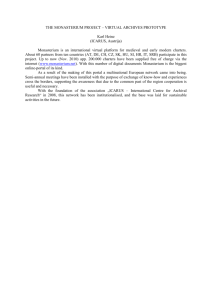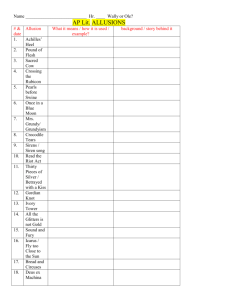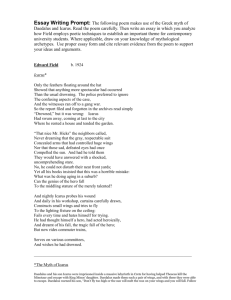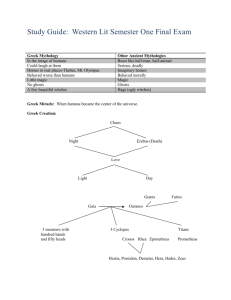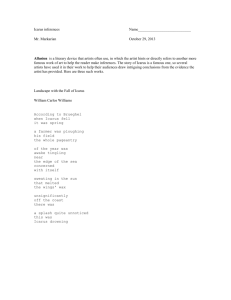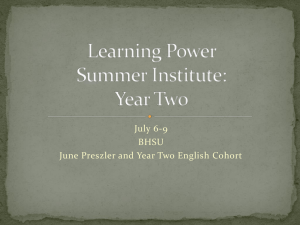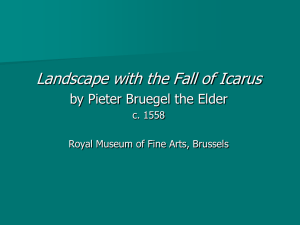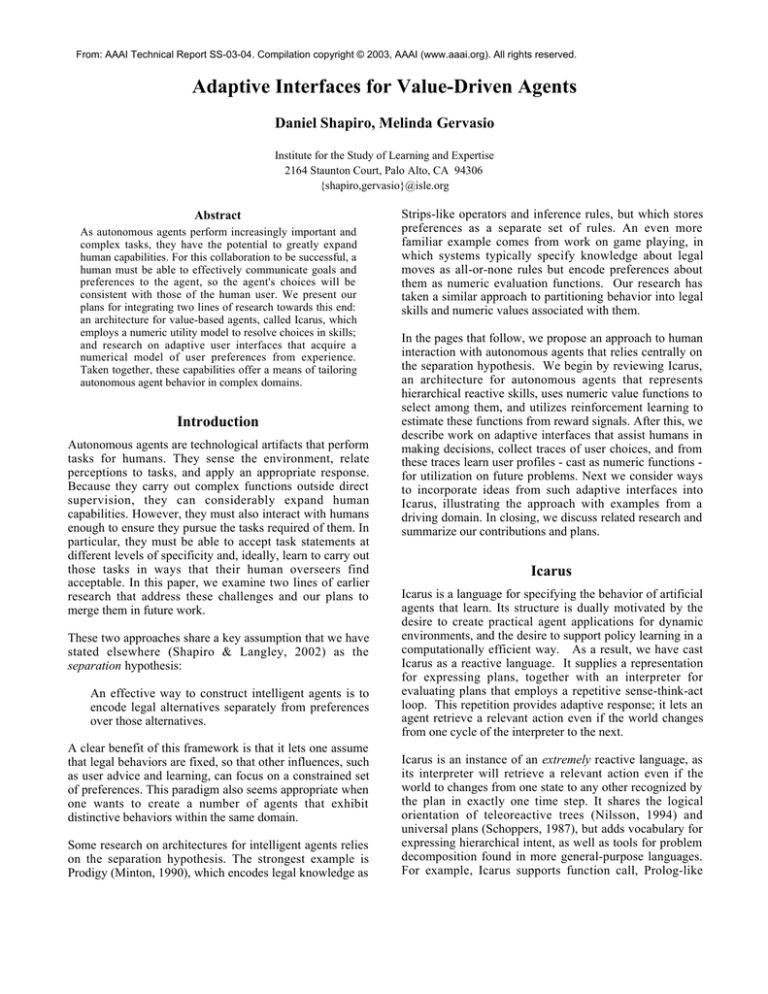
From: AAAI Technical Report SS-03-04. Compilation copyright © 2003, AAAI (www.aaai.org). All rights reserved.
Adaptive Interfaces for Value-Driven Agents
Daniel Shapiro, Melinda Gervasio
Institute for the Study of Learning and Expertise
2164 Staunton Court, Palo Alto, CA 94306
{shapiro,gervasio}@isle.org
Abstract
As autonomous agents perform increasingly important and
complex tasks, they have the potential to greatly expand
human capabilities. For this collaboration to be successful, a
human must be able to effectively communicate goals and
preferences to the agent, so the agent's choices will be
consistent with those of the human user. We present our
plans for integrating two lines of research towards this end:
an architecture for value-based agents, called Icarus, which
employs a numeric utility model to resolve choices in skills;
and research on adaptive user interfaces that acquire a
numerical model of user preferences from experience.
Taken together, these capabilities offer a means of tailoring
autonomous agent behavior in complex domains.
Introduction
Autonomous agents are technological artifacts that perform
tasks for humans. They sense the environment, relate
perceptions to tasks, and apply an appropriate response.
Because they carry out complex functions outside direct
supervision, they can considerably expand human
capabilities. However, they must also interact with humans
enough to ensure they pursue the tasks required of them. In
particular, they must be able to accept task statements at
different levels of specificity and, ideally, learn to carry out
those tasks in ways that their human overseers find
acceptable. In this paper, we examine two lines of earlier
research that address these challenges and our plans to
merge them in future work.
These two approaches share a key assumption that we have
stated elsewhere (Shapiro & Langley, 2002) as the
separation hypothesis:
An effective way to construct intelligent agents is to
encode legal alternatives separately from preferences
over those alternatives.
A clear benefit of this framework is that it lets one assume
that legal behaviors are fixed, so that other influences, such
as user advice and learning, can focus on a constrained set
of preferences. This paradigm also seems appropriate when
one wants to create a number of agents that exhibit
distinctive behaviors within the same domain.
Some research on architectures for intelligent agents relies
on the separation hypothesis. The strongest example is
Prodigy (Minton, 1990), which encodes legal knowledge as
Strips-like operators and inference rules, but which stores
preferences as a separate set of rules. An even more
familiar example comes from work on game playing, in
which systems typically specify knowledge about legal
moves as all-or-none rules but encode preferences about
them as numeric evaluation functions. Our research has
taken a similar approach to partitioning behavior into legal
skills and numeric values associated with them.
In the pages that follow, we propose an approach to human
interaction with autonomous agents that relies centrally on
the separation hypothesis. We begin by reviewing Icarus,
an architecture for autonomous agents that represents
hierarchical reactive skills, uses numeric value functions to
select among them, and utilizes reinforcement learning to
estimate these functions from reward signals. After this, we
describe work on adaptive interfaces that assist humans in
making decisions, collect traces of user choices, and from
these traces learn user profiles - cast as numeric functions for utilization on future problems. Next we consider ways
to incorporate ideas from such adaptive interfaces into
Icarus, illustrating the approach with examples from a
driving domain. In closing, we discuss related research and
summarize our contributions and plans.
Icarus
Icarus is a language for specifying the behavior of artificial
agents that learn. Its structure is dually motivated by the
desire to create practical agent applications for dynamic
environments, and the desire to support policy learning in a
computationally efficient way. As a result, we have cast
Icarus as a reactive language. It supplies a representation
for expressing plans, together with an interpreter for
evaluating plans that employs a repetitive sense-think-act
loop. This repetition provides adaptive response; it lets an
agent retrieve a relevant action even if the world changes
from one cycle of the interpreter to the next.
Icarus is an instance of an extremely reactive language, as
its interpreter will retrieve a relevant action even if the
world to changes from one state to any other recognized by
the plan in exactly one time step. It shares the logical
orientation of teleoreactive trees (Nilsson, 1994) and
universal plans (Schoppers, 1987), but adds vocabulary for
expressing hierarchical intent, as well as tools for problem
decomposition found in more general-purpose languages.
For example, Icarus supports function call, Prolog-like
Sense
Objectives
Means
World
Means
Act
Requirements
Figure 1. The structure of Icarus plans.
parameter passing, pattern matching on facts, and
recursion.
An Icarus program contains up to three elements: an
objective, a set of requirements, and a set of alternate
means (or methods for achieving objectives), as illustrated
in Figure 1. Each of these can be instantiated by further
Icarus plans, creating a logical hierarchy that terminates
with calls to primitive actions or sensors. Icarus evaluates
these fields in a situation-dependent order, beginning with
the objective field. If the objective is already true in the
world, evaluation succeeds and nothing further needs to be
done. If the objective is false, the interpreter examines the
requirements field to determine if the preconditions for
action have been met. If so, evaluation progresses to the
means field, which is the locus of all choice in Icarus.
Over time, Icarus will learn to select the alternative in the
means field that promises the largest expected reward.
We illustrate this reactive interpretation process using a
simple program for freeway driving shown in Table 1. It
contains an ordered set of objectives implemented as
further subplans. Icarus repetitively processes this plan,
starting with its first statement every execution cycle. The
first clause in Table 1 defines a reaction to an impending
collision. If this context applies, Icarus returns the slamon-the-brakes action for application in the world. If
emergency braking is not required, evaluation proceeds to
the second clause, which specifies a plan for reacting to
trouble ahead, defined as a car traveling slower than the
agent in the agent’s own lane. This subplan contains
options, as shown in Table 2. Here, the agent can move
one lane to the left, move right, slow down, or cruise at its
current speed and lane, although it does not allow the agent
to speed up. Icarus makes a selection based on the longterm expected reward of each alternative.
Table 1. The top level of an Icarus freeway-driving plan.
Drive ()
:objective
[ *not* (Emergency-brake())
*not* (Avoid-trouble-ahead())
Get-to-target-speed()
*not* (Avoid-trouble-behind())
Cruise()]
If there is no imminent collision or trouble in front, Icarus
will select an action from a later clause in Table 1. Get-totarget-speed is goal-driven subplan that causes the agent to
speed up if it is traveling too slow or slow down if it is
moving too fast. Avoid-trouble-behind specifies several
alternate reactions to a faster car approaching from behind.
If none of these contexts match, the fifth clause encodes
the default case: a primitive action that causes the agent to
Cruise in its current lane, at its current speed.
Since Icarus plans contain choice points, the interpreter
needs a method of selecting the right option to pursue.
Icarus provides this capability by associating a value
estimate with each Icarus plan. This number represents the
expected future discounted reward stream for choosing a
primitive action (or subplan) on the current execution cycle
and following the policy being learned thereafter. Icarus
computes this expected value using a linear function of
current observations.
The estimation architecture addresses an interesting tension
in information needs. On one hand, the value of a plan
clearly depends upon its context; the future of ‘decelerate’
is very different if the car in front is close or far. On the
other hand, the cardinal rule of good programming is "hide
information". We should not force Icarus programmers to
define subplans with a suite of value-laden parameters that
are irrelevant to performing the task at hand. Our solution
is to inherit context-setting parameters down the calling
tree. Thus, Avoid-trouble-ahead (Table 2) measures the
distance to the car in front, and Icarus implicitly passes that
parameter to the decelerate action several levels deeper in
the calling tree. The programmer writes Icarus code in the
usual fashion, without concern for this implicit data.
Table 2. An Icarus plan with alternate subplans.
Avoid-trouble-ahead ()
:requires
[ bind (?c, car-ahead-center())
velocity() > velocity(?c)
bind (?tti, time-to-impact())
bind (?rd, distance-ahead())
bind (?rt, target-speed() – velocity())
bind (?art, abs(?rt)) ]
:means
[ safe-cruise(?tti, ?rd, ?art)
safe-slow-down (?tti, ?rd, ?rt)
move-left (?art)
move-right (?art) ]
Learning with SHARSHA
SHARSHA is a reinforcement learning algorithm mated to
Icarus plans. It is a model-free, on-line technique that
determines an optimal control policy by exploring a single,
infinitely long trajectory of states and actions. SHARSHA
(for State Hierarchy, Action, Reward, State Hierarchy,
Action) adds hierarchical intent to the well-known SARSA
algorithm (for State, Action, Reward, State, Action).
While a detailed description of SHARSHA is outside the
scope of this paper, we can compare it to SARSA using
Figure 2 as a graphical aid. Like SARSA, SHARSHA
learns an estimate for the value of taking a given action in a
given state by sampling its future trajectory. However,
unlike SARSA, SHARSHA operates on stacks of stateaction pairs, where each pair corresponds to an Icarus
function encoding a plan to pursue a course of action in a
given situation. For example, at time 1 an Icarus agent for
piloting a car might accelerate to reach its target speed in
order to drive, while at time 2 it might brake in order to
avoid trouble as part of the same driving skill. Where
SARSA observes the current state, SHARSHA observes
the calling hierarchy, and where SARSA updates the
current state, SHARSHA updates the estimates for each
function in the calling stack (using the estimate associated
with the primitive action of the destination stack, which
contains the most informed picture of world state). Our
implementation of SHARSHA employs linear value
approximation functions, and it learns the coefficients of
these functions from delayed reward. We have proven
SHARSHA’s converge properties under a common set of
Markov assumptions (Shapiro, 2001).
SARSA
State, action
State, action
R(t)
Drive
SHARSHA Get to target
Accelerate
Drive
R(t)
Avoid trouble
Brake
Figure 2. A comparison of SARSA and SHARSHA.
change lane to the right, and emergency brake. The last
action instantaneously slows the vehicle such that it will
not collide with the car in front.
An experiment in programming by reward
A key tenet of the value driven agent model is that the
structure of skills can be productively separated from the
representation of preference, or values. If this separation
hypothesis holds, we should be able to define a single skill
for a common activity and produce a set of artificial agents
with qualitatively distinct behavior simply by changing the
reward function that serves as the target of learning.
We performed this experiment using the skill outlined in
Tables 1 and 2, and the reward functions in Table 3. Each
function is linear in the indicated features. For example,
the airport driver is solely motivated by the desire to get to
the airport on time, and becomes less happy as its velocity
deviates from target speed. The safe driver wants to avoid
collisions. Its reward function penalizes small times to
impact with cars in front and cars behind - the shorter the
time to impact, the larger the penalty. The goldfish driver
has an imaginary fishbowl as luggage and does not want
maneuvers to upend the fish. Alternatively, we can think
of it as a bit queasy, since its reward function penalizes all
forms of maneuver. Finally the reckless driver is out for
thrills; it garners reward for near misses, and penalizes
deviations from its target speed.
Table 3. Reward functions used as targets of learning.
Results with Icarus
We have used Icarus to generate a number of interesting
results concerning the power of the value-driven agent
model. We report on three of those results here: (1) an
experiment on ‘programming by reward’ which supports
our hypothesis that values can be treated separately from
skills; (2) a comparison between SHARSHA and SARSA
that demonstrates a two order of magnitude speedup in
learning (this speaks to the practicality of employing value
learning to acquire behavior); and (3) a proof that agent
Reward functions can always be aligned with human
utility. This last result addresses trust, and our willingness
to deploy autonomous agents in complex domains.
We conducted our experiments in a freeway-driving
domain, which consists of a simulator (written in C) that
manages several hundred cars on a three-lane, endless loop
freeway with no entrances or exits. With the exception of
one "smart" car that is capable of learning, each vehicle
maneuvers according to a fixed situation-action map. An
Icarus program controls the smart car. It can sense its own
target speed, the presence and relative velocity of six
surrounding cars, the distance to the car ahead and behind,
and whether it is safe to change lanes. There are six
primitive actions: speed up by two mph, slow down by
two, cruise at the current speed, change lane to the left,
Time to
impact
ahead
Time to
impact
behind
+
Speed
up
Change
lanes
−
−
+
−
Goldfish
Driver
Reckless
Driver
Slow
down
−
Airport
Driver
Safe
Driver
Delta
from
target
speed
−
−
−
We unleashed each of these agents to develop an action
policy via SHARSHA, using the identical skill for driving.
We profile the resulting behaviors in Figure 3 (see Shapiro
& Langley, 2002 for details). The most obvious feature is
that the agents evolve strikingly different policies as a
byproduct of learning. For example, the safe driver shows
the highest difference from target speed in the chart,
although it was not motivated (positively or negatively) by
that quantity. Apparently, it readily adjusts its velocity to
avoid potential collisions. The safe driver also shows the
largest following distance, which makes intuitive sense
since safe drivers know that tailgating produces potential
FEATURE VALUE RELATIVE TO SAFE DRIVER
1.6
1.4
Airport driver
Safe driver
Goldfish driver
Reckless driver
1.2
1
0.8
0.6
0.4
0.2
0
DIFFERENCE FROM
TARGET SPEED
FOLLOWING
DISTANCE
LANE CHANGE
SPEED CHANGE
CUTOFF
Figure 3. A profile of learned behaviors.
collisions. (If the car in front slows down, the safe driver
inherits a significant penalty.) In contrast, the goldfish
driver has the shortest following distance, similar to the
airport driver s. We explain this observation by a cruise
control effect: drivers who resist velocity changes will tend
to creep up on the car in front. Finally, the goldfish driver
performs the fewest cutoff actions (defined as a lane
change in front of a faster vehicle), as it is motivated to
avoid all maneuvers. In contrast, the reckless driver
actively seeks potential collisions, as they contribute
positive terms to its reward.
Note that the Icarus program for driving prevents the
reckless agent from simply colliding with the car in front;
its opportunity to learn is confined to an allowable realm.
Said differently, the agent s skills define legal behavior. Its
reward function is irrelevant whenever the behavior is
determined, and relevant only when choice is allowed.
This design frees us to construct reward functions for
Icarus agents in an unconstrained way.
Learning with background knowledge
Our second empirical investigation examines Icarus’ ability
to speed learning by encoding domain knowledge into the
structure of a plan. We measured the impact of plan
structure on learning by comparing the behavior of two
Icarus agents with the same Reward function but different
reactive programs (Shapiro, et al. 2001). The first
employed a standard reinforcement learning design; a
“flat” plan representing all feasible actions in every
situation. The second employed a “structured” plan,
specifically the driving program outlined in Tables 1 and 2.
Since the structured program contains fewer options (but
defines a smaller space of possible policies), we expected
the structured agent to learn faster, but achieve a lower
level of asymptotic reward.
The results of this experiment were surprising. As
expected, the structured agent learned faster than the flat
agent, but by approximately two orders of magnitude. In
addition, the structured agent performed better than the flat
agent even after 250,000 iterations of learning in the
driving domain. This leverage was largely due to reduced
plan size. When we counted the number of state-action
pairs in each design (somewhat after generating the
learning curves), we discovered a three order of magnitude
difference: the standard (flat) statement of the vehicle
control problem contained over 20,000 primitive
alternatives, while the hand-coded, structured plan
contained exactly 24 state-action pairs. Since our learning
algorithm (and reinforcement learning in general) searches
the space of possible action sequences, it is not surprising
that the “flat” agent failed to identify the better policy in
any reasonable period of time. In contrast, our ability to
obtain a two order of magnitude speed-up suggests that the
separation hypothesis is viable in practice, and that we can
employ value learning to refine agent behavior in nontrivial domains.
User-agent value alignment
In addition to programming an agent via its reward
function, we can design its reward function to be aligned
with human utility. The issue here is communication; since
humans and artificial agents necessarily sense the world in
different terms, we need a mechanism for capturing human
utility in a form that agents can represent. Value alignment
is a method of bridging this gap. In particular, structural
value alignment is a conditional independence relation that
ensures an agent can only impact human utility via features
the agent cares about as well. Given this relationship, we
can define a numerical manipulation of the agent’s reward
function that produces functional value alignment; the
happy situation in which the agent will always choose the
action preferred by the user. We have shown that it is
always possible to establish structural alignment, and thus
that we can achieve functional alignment between any user
and any agent (Shapiro, 2001).
Our mechanism for establishing alignment requires human
designers to (a) instrument the agent with features that
serve as surrogates for a subset of the features that
determine human utility, and (b) conduct a series of
simultaneous assessment experiments that set the agent’s
Reward for a perceived situation, x, equal to the human’s
expected utility for the corresponding situation, y. This is
always possible (as x can be the full set of agent actions
and observations), but the assessment problem can become
quite large in the absence good surrogate features. We are
exploring methods for minimizing this cost.
User-agent value alignment has a profound consequence
that we call the “be all you can be” guarantee: it ensures
that an aligned agent will do everything it possibly can to
maximize human utility, and it tells us this fact before the
agent is deployed to learn from its environment. This
property should increase our willingness to trust highly
autonomous artificial agents, and thus to employ them in a
greater variety of applications.
In summary, our work with Icarus has shown that the
value-driven agent architecture provides many desirable
abilities. We can: program by value without implementing
new skills; employ value learning in a practical way; and
elevate the problem of behavior verification into a
discourse about value alignment. However, many tasks
require more coordination between agents and users than
Icarus currently supports, since it places all such
interactions at design time. The next section discusses our
work on adaptive user interfaces, which support an on-line
interaction over value.
Adaptive Interfaces
Adaptive user interfaces (Langley, 1999) are assistant or
advisory systems that learn to tailor their behavior to
individual users by utilizing profiles that capture user
preferences. Through the use of machine learning
techniques, these systems can automatically acquire user
profiles from traces of user decisions and thus provide
increasingly personalized service with experience. Over
the past several years, we have developed a variety of
adaptive user interfaces, including a driving route advisor
(Rogers et al., 1999), a crisis response scheduler (Gervasio
et al., 1999), a destination advisor (Goker & Thompson,
2000), and a stock tracker (Yoo et al., 2003). Given a trace
of user decisions, these systems apply machine learning to
acquire content-based user profiles that represent user
preferences in terms of item attributes. They also
emphasize unobtrusive data collection techniques, which
extract preference information from a user's natural
interaction with the system.
For example, INCA (Gervasio et al., 1999) is a scheduling
assistant for hazardous material incident response that
learns a user's preferences for addressing the different
hazards involved in a situation. Given an incident, it
carries out an interactive search through the space of
possible response schedules. On each cycle, INCA
generates a set of candidate schedules and shows them to
the user, who selects one for further development. This
interaction repeats until INCA generates a schedule that the
user finds acceptable. In evaluating candidate schedules,
INCA relies on a utility function (a linear evaluation
function) on schedule attributes. The user's decisions
provide feedback regarding the evaluation and are
translated into training data for updating the weights of the
utility function using a modified perceptron algorithm.
Experimental studies with INCA have shown that this
approach can be used to acquire user profiles that reflect
different individual preferences. Through these profiles,
INCA can provide increasingly personalized assistance to
support more effective crisis response.
INCA also demonstrates a variable level of autonomous
behavior. In particular, a user can tell INCA how it should
attempt to improve the current schedule at different levels
of detail. At the highest level, a user may simply select,
"improve schedule", which lets INCA explore
improvements along all dimensions. At the lowest level, a
user can choose to address a specific hazard by specifying
particular actions, start times, durations, and resources.
Experimental studies have shown that more detailed
guidance leads to more rapid learning. However, by
providing users with variable levels of assistance, INCA
can encompass not only different preferences regarding
crisis response schedules but also individual differences in
the amount and type of assistance desired or required.
In designing our adaptive user interfaces, we have focused
on exploiting the preference information that is implicit in
a user's decisions. For example, by selecting a schedule in
INCA, the user indicates a preference for that schedule
over the others presented. When asking for improvement
along particular dimensions, the user indicates the
importance of the associated features. Our general
approach to adaptive user interfaces does not exclude the
use of more explicit user input such as numeric
evaluations, relative rankings, or even statements about
general preferences. However, by focusing on the
information that is readily available through a system's
interaction with the user, we can support more natural
interfaces that require little or no extra effort on the human
user's part to achieve personalization.
While our work to date has demonstrated the ability to
acquire user preferences in a non-obtrusive way, we have
focused on recommendation tasks that require very little
autonomy on the part of the underlying system. At most,
they have involved one-step modifications of already
generated alternatives, such as the schedules in INCA or
the driving routes in the Adaptive Route Advisor (Rogers
et al., 1999). However, the same technology should
support dialogues over preference in more complex
applications, such as the interaction between humans and
highly autonomous artificial agents.
An adaptive interface for Icarus
We believe that value-driven architectures like Icarus and
adaptive interfaces like INCA hold great potential for
synergy. As we have noted, the current version of Icarus
cannot learn from user advice, while adaptive interfaces
support one-step decision-making tasks rather than
complex control problems. However, since both
frameworks view behavior as emerging from the selection
of legal alternatives based on numeric value functions,
their integration should be relatively straightforward. Our
approach is to augment the Icarus architecture to
incorporate techniques from adaptive interfaces for
collecting, and learning from, user input.
We can illustrate this synthesis in the domain of freeway
driving, this time assuming that there is a human passenger
who can give advice and directions to an autonomous
limousine driver. The Icarus agent should both follow any
legal advice that it receives from the backseat driver and,
over time, learn the (opinionated) passenger's preferences
so that he must give fewer directions. The autonomous
agent pilots the car by executing an Icarus program like
that in Tables 1 and 2, while the user observes the traffic
situation and provides advice of the form, “Slow down!”
“Change lanes to the right!” and "Go around that guy!"
whenever he/she disagrees with the agent's current choice.
This form of user input differs somewhat from that
assumed by most adaptive interfaces. For example, INCA
presents its user with explicit choices about revisions to a
schedule, and asks the user to select one over the others.
However, the literature on adaptive interfaces contains a
few examples of systems that let users correct undesired
behaviors. For example, Billsus and Pazzani's (1999) News
Dude lets its user interrupt a news story he does not want to
hear, whereas Hermens and Schlimmer's (1994) adaptive
form filler lets its user overwrite entries he thinks should
have different values.
This example reflects another difference from traditional
adaptive interfaces, in that the system can accept advice at
different levels of detail. Icarus is well suited to support
this facility, because its hierarchy of skills lets users
specify higher-level actions (e.g., passing) without stating
the details of how the agent should execute them (e.g., on
the left or right). INCA also has this capability, though it is
perhaps the only adaptive interface to date that supports
multi-level advice.
We must also modify Icarus to learn from traces of user
corrections that it collects in this manner. Recall that the
current architecture estimates the value functions
associated with each skill from a reward signal it observes
on each time step. In the new setting, the agent receives
corrections when the user disagrees with its action and no
feedback on other cycles. Thus, the user's feedback
concerns preferred action rather than the numeric data
assumed in learning from delayed reward. In effect, the
user forces the agent to alter its policy, making the
traditional concern with policy exploration irrelevant.
Fortunately, we can adapt the method of learning used in
INCA almost directly to the new version of Icarus.
Suppose the agent is executing Cruise when the user says
"Slow down", and slowing down is a legal skill in the
current situation. In addition to executing this action, we
want the system to alter the weights associated with the
Slow down and Cruise skills so the latter has a higher value
in this context. INCA utilized a modified version of the
perceptron algorithm to revise the weights on its utility
function, and Icarus can utilize a similar technique. The
main difference is that the system must revise the
parameters on an entire set of Icarus skills rather than a
single utility function that represents the user profile.
We plan to implement this variation on Icarus and evaluate
its ability to learn user preferences through a controlled
experiment. In particular, we will initialize the agent with
some fixed set of value estimation functions, provide it
with user feedback during the course of its operation, and
record the user corrections that occur over time. From this
trace, we will utilize a sliding window to compute the
probability of user corrections as a function of driving
time. This metric will serve as a measure of user
disapproval. We will also evaluate user satisfaction via a
questionnaire.
In this context, we can make four predictions about the
behavior of the system over time. First, the probability of
user corrections will decrease monotonically as the agent
gains experience with the user. Second, this probability
will move towards an asymptote that reflects the best
policy the agent can express within its legal skills. Third,
the system will reach this point of diminishing returns after
an acceptably small number of user corrections. Finally, we
predict that addition of further parameters to value
estimation functions will decrease that asymptote but slow
down the rate at which the system approaches it.
These hypotheses describe the behavior of a successful
merger between adaptive interfaces and value-driven agent
architectures, as they depend upon the abilities to (a) learn
numeric preferences from advice about action obtained in
an unobtrusive way, and (b) to rapidly acquire action
policies in the presence of background knowledge. In
addition, we hope to compare this approach to a
reinforcement learning design that induces action policies
from numeric user feedback. We would expect the first
approach to learn faster, since it relies on advice about
action that obviates the attribution problem. We also
anticipate that our questionnaires will reveal that users find
it more natural to interact with the driving agent by stating
preferred action. If these hypotheses are confirmed, we
will have made significant progress toward developing a
practical mechanism for tailoring the behavior of
autonomous agents in complex environments.
Related work on Control Learning
As we have noted, our approach to human interaction with
autonomous systems draws on two distinct research
traditions. The first involves architectures for intelligent
agents, which typically represent knowledge about problem
solving and action as condition-action rules, and which
chain this knowledge together to produce complex
behavior. Well-developed examples of this general
approach include SOAR (Laird & Rosenbloom, 1990),
Prodigy (Minton, 1990), and ACT-R (Anderson, 1993).
Icarus diverges from these efforts by grouping knowledge
into larger skills, but it shares ACT-R's decision-theoretic
approach to selecting among alternative knowledge
structures. Our architecture comes even closer to Sun et
al.'s (2001) CLARION, which combines symbolic
structures with numeric functions that it learns from
delayed reward. However, systems cast within these
architectures are usually designed to be autonomous, rather
than to achieve a user's goals.
The second research tradition concerns adaptive user
interfaces (Langley, 1999), which learn user profiles from
traces of interactions with those users. These systems are
highly interactive and devote themselves to serving the
user's interests, but they have typically focused on
classification tasks like filing email (e.g., Segal & Kephart,
1999), recommending news stories (e.g., Billsus &
Pazzani, 1999), and suggesting stock trading actions (e.g.,
Yoo et al., 2003). In contrast, our own work in this area
has concentrated on adaptive systems that help users solve
complex problems like scheduling (Gervasio et al., 1999)
and route finding (Rogers et al., 1999). However, we cast
user profiles in terms of numeric utility functions and our
systems infer the weights in these functions from data
about user choices, which simplifies unification of this
approach with the Icarus architecture.
We should also mention some additional research
paradigms that are related to our approach, but which have
influenced our thinking less directly. One approach, known
as advisable planning, adapts planning methods to accept
high-level advice from humans in the form of goals or
constraints. However, work in this area (e.g., Myers, 1996)
differs from ours by emphasizing advisory input at the
outset of planning, rather than during execution. Moreover,
work on advisable planning generally assumes new advice
for each problem, rather than learning user preferences
from each interaction that carry across sessions.
Another framework, known as behavioral cloning, aims to
learn control policies by observing another agent's
behavior. For example, Sammut (1996) and Anderson et
al. (2000) describe systems that record traces of human's
actions when flying a simulated aircraft, transform these
traces into supervised training cases, and induce reactive
policies for controlling the aircraft autonomously. This
framework differs from ours in its reliance on detailed
traces of human behavior rather than occasional and
possibly high-level advice, and in its emphasis on learning
unstructured policies rather than incorporating human
preferences into a hierarchy of skills. Ichise et al. (2002)
have used behavioral cloning methods to learn the structure
of a skill hierarchy, but they have not combined this idea
with value functions for selecting skills.
An older approach relies heavily on domain knowledge to
interpret observed behaviors and thus to learn more
complex controllers. This paradigm includes some, but not
all, approaches to explanation-based learning (e.g., Segre,
1987), learning apprentices (e.g., Mitchell, 1985), and
programming by demonstration (e.g., Cypher, 1993).
However, these methods are concerned primarily with
learning the qualitative structure of skills, rather than
learning to select among alternative choices within an
existing structure. Moreover, they emphasize nondynamic
domains that do not require the type of reactivity we
designed Icarus to support.
Summary
We have developed an approach that promises to support
human interaction with autonomous systems in complex
environments. The key tenet is that we can productively
separate the concepts of value and skills. This allows us to
express user preferences as value functions within an
architecture for value-driven agents, and to employ
adaptive interface technology to acquire appropriate value
functions through user feedback about action. Our results
to date suggest that this approach can express a wide
variety of preferences and policies, that it offers a noninvasive user interaction model, and that it phrases the
underlying learning problems in a computationally
tractable form.
Acknowledgements
We thank Pat Langley for his many contributions to this
work.
References
Anderson, C., Draper, B., & Peterson, D. (2000).
Behavioral cloning of student pilots with modular neural
networks. Proceedings of the Seventeenth International
Conference on Machine Learning (pp. 25--32). Stanford:
Morgan Kaufmann.
Anderson, J.R. (1993). Rules of the mind. Hillsdale, NJ:
Lawrence Erlbaum.
Billsus, D., & Pazzani, M. (1999). A personal news agent
that talks, learns and explains. Proceedings of the Fifth
International Conference on Autonomous Agents (pp. 268-275). Seattle: ACM Press.
Cypher, A. (Ed.). (1993). Watch what I do: Programming
by demonstration. Cambridge, MA: MIT Press.
Engelmore, R., and Morgan, A. eds. (1986). Blackboard
Systems. Reading, Mass.: Addison-Wesley.
Gervasio, M. T., Iba, W., & Langley, P. (1999). Learning
user evaluation functions for adaptive scheduling
assistance. Proceedings of the Sixteenth International
Conference on Machine Learning (pp. 152-161). Bled,
Slovenia: Morgan Kaufmann.
Goker, M. & Thompson, C. (2000). Personalized
conversational case-based recommendation. Proceedings
of the Fifth European Workshop on Case Based Reasoning.
Trento, Italy
Hermens, L. A., & Schlimmer, J. C. (1994). A machinelearning apprentice for the completion of repetitive forms.
IEEE Expert, 9, 28--33.
Segre, A. (1987). A learning apprentice system for
mechanical assembly. Proceedings of the Third IEEE
Conference on AI for Applications (pp. 112--117).
Shapiro, D. (2001). Value-driven agents. PhD thesis,
Department of Management Science and Engineering,
Stanford University, Stanford, CA.
Ichise, R., Shapiro, D. G., & Langley, P. (2002). Learning
hierarchical skills from observation. Proceedings of the
Fifth International Conference on Discovery Science.
Lubeck, Germany: Springer.
Shapiro, D., Langley, P., & Shachter, R. (2001). Using
background knowledge to speed reinforcement learning in
physical agents. Proceedings of the Fifth International
Conference on Autonomous Agents (pp. 254--261).
Montreal: ACM Press.
Laird, J.E., & Rosenbloom, P.S. (1990). Integrating
execution, planning, and learning in SOAR for external
environments. Proceedings of the Eighth National
Conference on Artificial Intelligence (pp. 1022--1029).
Boston, MA: AAAI Press.
Shapiro, D., & Langley, P. (2002). Separating skills from
preference: Using learning to program by reward.
Proceedings of the Nineteenth International Conference on
Machine Learning (pp. 570-577). Sydney: Morgan
Kaufmann.
Langley, P. (1999). User modeling in adaptive interfaces.
Proceedings of the Seventh International Conference on
User Modeling (pp.357-370). Banff, Alberta: Springer.
Schoppers, M. (1987). Universal Plans for reactive robots
in unpredictable environments. Proceedings of the Tenth
International Joint Conference on Artificial Intelligence
(pp. 1039-1046). Morgan Kaufmann.
Minton, S.N. (1990). Quantitative results concerning the
utility of explanation-based learning. Artificial Intelligence,
42, 363--391.
Mitchell, T.M., Mahadevan, S., & Steinberg, L. (1985).
Leap: A learning apprentice for VLSI design. Proceedings
of the Ninth International Joint Conference on Artificial
Intelligence (pp. 573--580). Los Angeles: Morgan
Kaufmann.
Myers, K.L. (1996). Strategic advice for hierarchical
planners. Principles of Knowledge Representation and
Reasoning Proceedings of the Fifth International
Conference (pp. 112-123). San Francisco: Morgan
Kaufmann.
Nilsson, N. (1994). Teleoreactive programs for agent
control. Journal of Artificial Intelligence Research, 1, 139158.
Rogers, S., Fiechter, C., & Langley, P. (1999). An adaptive
interactive agent for route advice. Proceedings of the Third
International Conference on Autonomous Agents (pp. 198-205). Seattle: ACM Press.
Sammut, C. (1996). Automatic construction of reactive
control systems using symbolic machine learning.
Knowledge Engineering Review, 11, 27--42.
Segal, R., & Kephart, J. (1999). MailCat: An intelligent
assistant for organizing e-mail. Proceedings of the Third
International Conference on Autonomous Agents (pp. 276-282). Seattle: ACM Press.
Sun, R., Merrill, E., & Peterson, T. (2001). From implicit
skills to explicit knowledge: A bottom-up model of skill
learning. Cognitive Science, 25, 203--244.
Yoo, J., Gervasio, M., & Langley, P. (2003). An adaptive
stock tracker for personalized trading recommendations.
Proceedings of the 2003 International Conference on
Intelligent User Interfaces. New Orleans, LA.

